Egyptian Schools for Scribes Inflicted Ten to Twelve Years of Intensive Training and Discipline on Those Who Desired the Advantages of This Profession, Part 2The Egyptian brush-pen was made from a thin-stemmed rush, or reed, plant that was usually cut to a length of about nine inches. When it was chewed or hammered soft at one end, it easily frayed and, when trimmed, it held enough ink to keep writing several letters, depending on their sizes, before it needed re-inking. While the small boys were trying to learn how to draw the special symbols, older boys tutored the younger ones or learned to take dictation on papyrus while the teacher recited proverbs. One of the proverbs that was discovered says, “Give thy heart to learning and love her like a mother, for there is nothing as precious as learning.” The first stage of Egyptian writing from the earliest days of Egyptian literacy, was named hieroglyphic (“sacred engraved writing”) by the Greeks who first saw it about 2,000 years later. It has survived as the writing style appropriate to religious and monumental inscriptions long after the two later stages, known as hieratic and demotic script had been developed from it. All three styles have remained essentially picture-writing systems, consisting of a combination of pictograms, ideograms, and phonograms, even after the simpler principle of alphabetic signs had evolved. 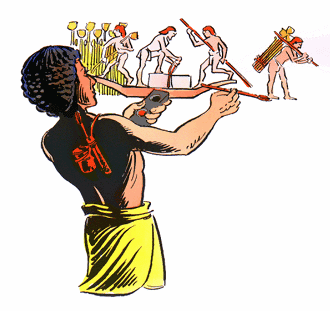 The harvesting of the papyrus plant was an important industry in Egypt and an essential product for the scribes and their record keeping. This marsh and river-side plant gave us the word “paper” and had other important uses. Some stalks were harvested for fuel, others were tied in bunches to make beams or supports for simple houses, and some were smeared with a resinous material and made into flat-bottomed boats. In addition, the bark from the stalks were woven into baskets and hampers while the roots were used for food. It was the yellowish, fibrous centers of papyri, cut into thin slices, which gave Egyptians the writing material they could use for keeping records, writing poetry, stories, etc. Reed pens were better than rush brushes for writing on the papyrus sheets. Scribes made their own pens from reed stalks and carried extras for the work they had to do. The Egyptians didn’t have much in the way of trees to use for extensive writing or construction purposes, such as bark or a supply of wood. In the many marshes; however, they had a common river plant which had branchless seed-stalks that they called “gomeh”. The Greeks and Romans called the plant “papyrus” from which our word paper came. After the papyrus was cut and the internal fibers flattened into strips, they were laid side by side on a flat surface. They were then covered with another layer placed crosswise. Next, some cooked vegetable gum would be poured over the sheets thus filling up spaces in the pithy centers as well as holding the strips together. Finally the sheet would be pressed, pounded, and rubbed smoothly; then made into rolls by pasting several sheets end to end. >P?The intellectual profession of Egyptian scribes was quite different from the trades of such laborers as metal smiths or stone masons. The scribes took great pride in the tools and materials of their craft. In fact, the word for “scribe” in hierogyphic writing combined pictures of the writer’s implements—ink palette, water jar, and brushes—with the pictograph of a man: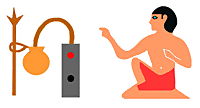 A 4,700-year-old wooden carving, that was discovered in Egypt, shows Hesire, chief of the royal Egyptian scribes, with his professional tools positioned over his right shoulder. The writing kit included a slate palette with two depressions for holding ink cakes (usually black and red), a wooden case to hold a rush (reed) brush or two, and a small container for water which was used to get the brush wet. The three elements were tied together with twine made of flax fibers: The hieroglyph for “writing” was 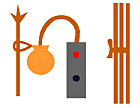 The ink that the Egyptian scribes used was so stable that it has kept its dense black color after thousands of years. The black ink was made of carbon, usually fine soot, mixed with water and a binding agent such as gum. The red ink was made in the same way, prepared with pigment made from one of the many red oxides that occur naturally in the earth. Red ink was often used to indicate titles and headings and the beginnings of new “paragraphs” or sections. 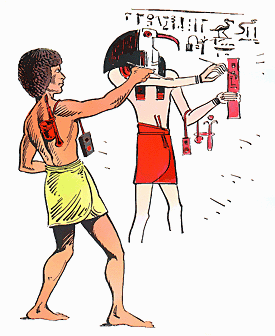 A scribe is shown drawing Thoth, the divine patron of scribes, carrying the traditional palette, water container, and rush brushes or reed pens. This illustration is based on a section from a 13th Century B.C. funerary (tomb or place of burial) text written down on papyrus. Thoth was believed to be the “inventor” of all arts and sciences including the Egyptian system of hieroglyphics. 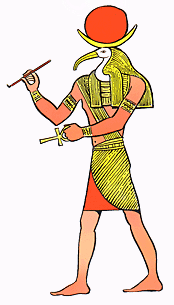 As the god of magic words and writing, Thoth was identified with the Greek god, Hermes. His holy city became Hermopolis (City of Hermes). The Book of Thoth was a famous legendary work that was supposed to reveal the secrets of manipulating matter with verbal charms. You may return to the Scrib, Script list to see those words again, if you wish to do so.
If you want to do more Latin-Greek-English cross references searches, this link will take you to the word-entry page.
|